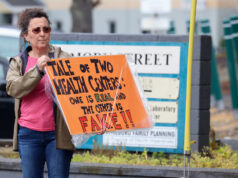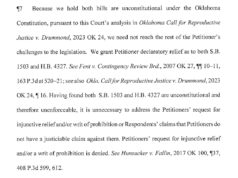The United States saw more than 700,000 Google searches for phrases related to “how to give yourself an abortion” in 2015, according to a recent and shocking column in the New York Times.
Headlined “The Return of the D.I.Y. Abortion,” Seth Stephens-Davidowitz’s piece attempts to quantify a perceivable correlation between states that have extreme abortion restrictions and states where people more frequently searched for home-abortion techniques or advice.
The results seem to show a fairly clear cause and effect.


From Stephens-Davidowitz:
Search rates for self-induced abortion were fairly steady from 2004 through 2007. They began to rise in late 2008, coinciding with the financial crisis and the recession that followed. They took a big leap in 2011, jumping 40 percent. The Guttmacher Institute singles out 2011 as the beginning of the country’s recent crackdown on abortion; 92 provisions that restrict access to abortion were enacted. There was not a comparable increase in searches for self-induced abortions in Canada, which has not cracked down.
While the Times author notes that it’s impossible to know how many search engine queries for do-it-yourself abortions result in a woman attempting such a procedure, logic would dictate that more than a few of the hundreds of thousands of searches took some sort of action. It’s a tough concept to imagine, but it happens.
Equally tough, perhaps, is to read the Guttmacher Institute’s estimate that the U.S. has about one million legal abortions annually.
You don’t have to be anti-choice to think that’s a large number, and it means the Pope may have more forgiving to do this year than you may have previously realized.
Samantha Bee tackles tough issue with sad humor
As with most awful topics, some levity here might be useful. Former Daily Show correspondent Samantha Bee recently tackled the U.S. Supreme Court’s pending decision on Texas’ controversial HB 2, an anti-abortion measure that forces abortion clinics to close unless they can meet a stringent set of building codes to become a surgery center.
While the whole piece is worth watching, the chilling moment at the 3:33 mark caught my attention.
“We’re hearing from doctors that more women are asking them, ‘Can I throw myself down the stairs? Can I drink bleach? Can I douche with bleach?'” says Bee’s guest, Ilyse Hogue, president of NARAL Pro-Choice America, a 501(c)(4) advocacy organization.
Bee herself goes on to ask Texas Rep. Dan Flynn why his bill didn’t seek to regulate “back alleys,” and Flynn painfully denies that abortions are happening outside of medical facilities.
“I don’t believe it. Where are you getting those numbers?” he asks.
Bee replies, “Reality,” before citing a report.
We should all be shocked
While it’s fun for Bee’s pro-choice viewers to look at Flynn and guffaw at his ignorance, it should also be shocking for Flynn’s anti-abortion supporters to see the number of self-inflicted abortions being carried out already in America.
Further, it should be concerning that state-level efforts to regulate abortion out of fashion appear to be diverting desperate, vulnerable young women away from medical professionals and to Dr. Google, with his hilarious shingle that changes daily and his pernicious list of search results for, “Can I douche with bleach?”
(No, and it doesn’t prevent AIDS, either, kids.)
Rational conversation needed
As I also wrote Monday on the topic of the abortion debate, rational conversation is needed. Rep. Flynn going on Bee’s show in denial of DIY abortions’ existence stands emblematic of just how dysfunctional the abortion discussion has become.
RELATED
Filter: Anti-abortion folks take fetus pics to art walk by William W. Savage III
Meanwhile, after publicly inviting the Abolish Abortion OK group the opportunity to publish a commentary on NonDoc about their beliefs and cause, we’ve heard crickets the past three days.
Should we be surprised in this day and age that an advocacy group would rather toss pictures of aborted fetuses around outside art galleries than write about the details of their policy proposals? Probably not.
And while normally we might chalk a group’s silence up to them simply not knowing about our little website, Abolish Abortion OK most certainly knows about NonDoc, seeing as how they stole a photo of ours and posted it on their site just last week.

Bills before the Oklahoma Legislature now
While all of these discussions, reports and demonstrations have taken place, Oklahoma has its own abortion bills gestating in the Legislature currently.
Among them, SB 1118 is getting a fair amount of press because Sen. Joseph Silk (R-Broken Bow) has filed a floor substitute to make abortion tantamount to murder in Oklahoma. Reports on KTOK radio Wednesday morning indicated Silk is upset because the full Senate has not granted him a hearing on it.
Meanwhile, HB 2797 is still a thing, and it will be interesting to see whether the new anti-abortion education funds proposed within it ultimately move forward when the state is facing steep cuts in education and health care.
HB 3128, on the other hand, would make it illegal for any doctor to perform an abortion on a woman known to be seeking the abortion because the unborn child has been diagnosed with Down syndrome or another disability. (That’s a lot of sadness to chew on for one bill.)
SB 1552 just says “screw Roe v. Wade” and labels the performance of an abortion as “unprofessional conduct” for medical providers. The Senate approved it 40-7 on Tuesday.
Yes, indeed, the march to abolishing abortion — despite the famous SCOTUS ruling on the topic — continues. But as the New York Times’ article and charts warn us, making abortion illegal is not the same thing as stopping abortion.
If advocates succeed, however, perhaps they will then need to focus on banning the ability to Google certain phrases.























